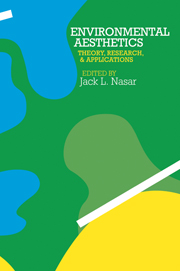Book contents
- Frontmatter
- Contents
- List of figures
- List of tables
- List of contributors and participants
- Acknowledgments
- Preface
- Section I Theory
- Section II Empirical studies
- Editor's introduction
- A Methodological comments
- Editor's introduction
- 9 The assessment of landscape quality: an integrative approach
- 10 Affective appraisals of environments
- B Architectural interiors
- C Architectural exteriors
- D Urban scenes
- E Natural and rural scenes
- Section III Applications
- References
- Index of authors
- Subject index
10 - Affective appraisals of environments
Published online by Cambridge University Press: 05 September 2013
- Frontmatter
- Contents
- List of figures
- List of tables
- List of contributors and participants
- Acknowledgments
- Preface
- Section I Theory
- Section II Empirical studies
- Editor's introduction
- A Methodological comments
- Editor's introduction
- 9 The assessment of landscape quality: an integrative approach
- 10 Affective appraisals of environments
- B Architectural interiors
- C Architectural exteriors
- D Urban scenes
- E Natural and rural scenes
- Section III Applications
- References
- Index of authors
- Subject index
Summary
When we think about or encounter an environment, perhaps the most important judgment we make about it is whether it is interesting, gloomy, frightening, relaxing, or such. Whether we choose to go there, what we do there, and whether we return may be largely determined by such judgments, which I shall call affective appraisals.
Understanding affective appraisals requires knowledge in at least three related areas: (1) the nature of affective appraisals themselves, including some means of describing and measuring them; (2) the relationship of affective appraisals to physical or objective properties of environments; and (3) the relationship of affective appraisals to other psychological processes, including behavior, emotion, and cognition. In the rush to gather needed information on the second two topics, the first has been somewhat neglected, and it is the focus of this paper.
A characterization of affective appraisals
An affective appraisal occurs when a person judges something as having an affective quality, such as being pleasant, likable, exciting, and soon. Affective appraisals thus resemble both emotions and cognitions. They resemble emotions in that they concern affective feelings. They resemble cognitions in that they are one aspect of how someone interprets something. Still, we must distinguish affective appraisals from other phenomena that fall under the headings of emotion and cognition.
That, by the definition above, affective appraisals are judgments (and hence mental events) distinguishes them from the physiological and behavioral components of emotion.
- Type
- Chapter
- Information
- Environmental AestheticsTheory, Research, and Application, pp. 120 - 130Publisher: Cambridge University PressPrint publication year: 1988
- 15
- Cited by



